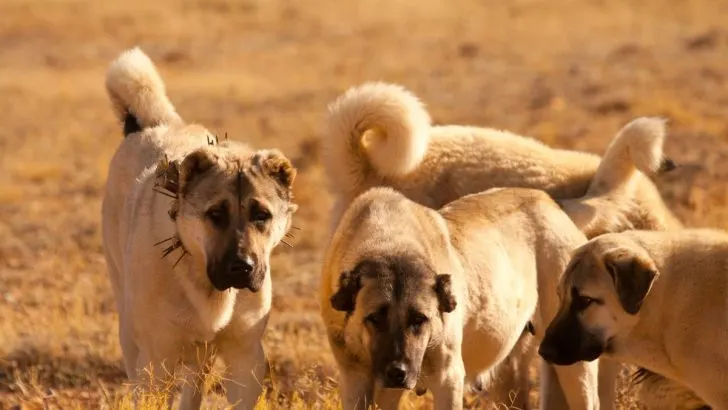In this article we’ll cover beautiful Anatolian Shepherd colors & markings. Every coat color and pattern has a special story.
These amazing dogs come in lots of different colors, like warm fawn, cool brindle, and pure white. But they also inherit cool designs on their fur, like bold stripes or fancy masks.
The Anatolian Shepherd dog is a strong and impressive guard dog with a long history. These loyal family members are known for being smart, calm, and protective. They stand very tall too! We are talking around 27 to 29 inches, and can weigh up to 150 pounds.
Owning one means being a strong leader, ready to handle their loving yet assertive nature.
As we check out Anatolian Shepherd colors, we’re uncovering their amazing history along the way, and enjoying the awesome beauty they bring today.
Anatolian Shepherd Colors Registered By The American Kennel Club
Initially the breed was recognized in the United States by the American Kennel Club back in 1996. Since then there has been a rising interest in these dogs. In fact, they have been ranked 79 of 201 on the AKC breed popularity ranking.
Now for the colors. There are eight correct colors and six unique markings registered by the AKC. Anatolian Shepherd enthusiasts are truly treated to a colorful palette that reflects the breed traits.
These breed colors & markings are also recognized by the Anatolian Shepherd Dog Club of America. So if the plan is to compete with your dog in conformation shows, you’re good to go.
Without any further ado let’s take a look at each of the following colors.
1. Biscuit & White

The Biscuit and White Anatolian Shepherd showcases a stunning coat characterized by a light cream fawn color with a delicate white overlay.
Within the Biscuit & White variation, the white markings are more subdued but still add a captivating contrast to the overall appearance.
Despite the lightness of the coat, the snout maintains its characteristic black hue.
2. Fawn

Fawn is the predominant base color found in Anatolian Shepherds, often seen without any other markings or mask. This color can range from a light cream to a deep red shade.
Variations within fawn include “Red Fawn,” and “Gray Fawn,” which features sable markings with black tipping or banding.
The most commonly observed color combination in Anatolian Shepherds is Fawn with a Black Mask. In fact the fawn/black mask pairing is quite traditional.
3.Brindle

Anatolian Shepherds have a variety of colors and patterns, and one that’s becoming more popular is brindle. Although considered rare, Brindle Anatolian Shepherds have been present in the US since the 1980s. Right now this pattern can also be found in shepherd dogs in Turkey today.
This color resembles tiger stripes on their coat and is found on the same part of their DNA as the fawn color. We can see these colors in Cane Corso dogs, Boxers, and Greyhounds.
The color or pattern of a dog doesn’t affect its performance, temperament, or work ability. However, some people prefer brindles because they blend in well with our forested surroundings.
This “camouflage” gives dogs an advantage if a predator decides to target them for a meal.
4. Blue Fawn
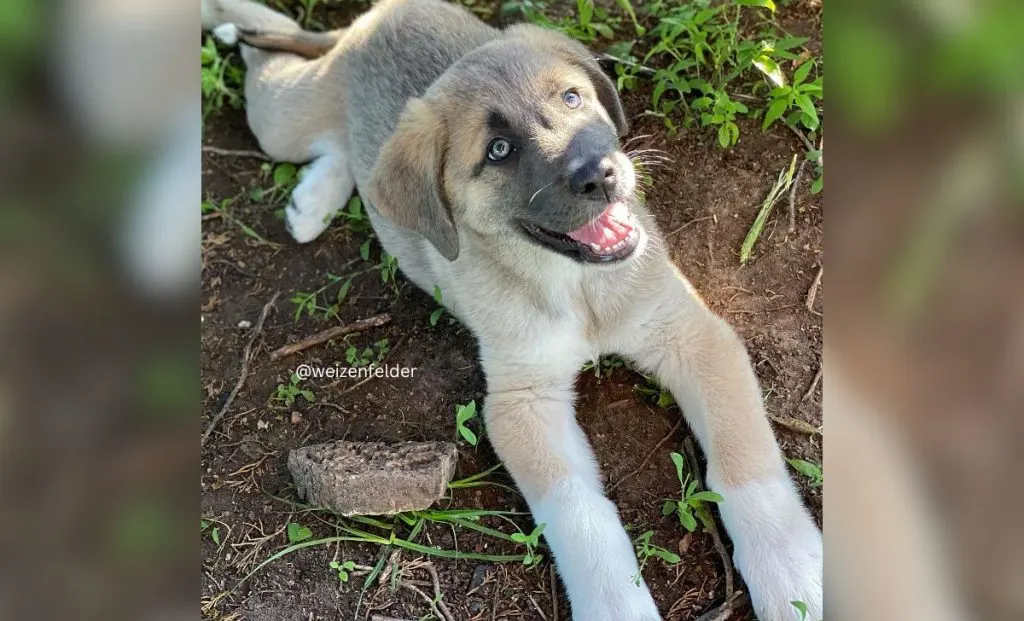
A Blue Fawn Anatolian Shepherd is a striking variation of the breed characterized by a unique coat color.
The term “blue fawn” refers to a dilute fawn coloration, resulting in a softer, bluish-gray hue compared to the traditional fawn coat.
This coloration can vary in intensity, ranging from a lighter, almost silver-blue shade to a deeper, steel-gray tone.
Additionally, their nose may also turn blue!
5. Gray Fawn
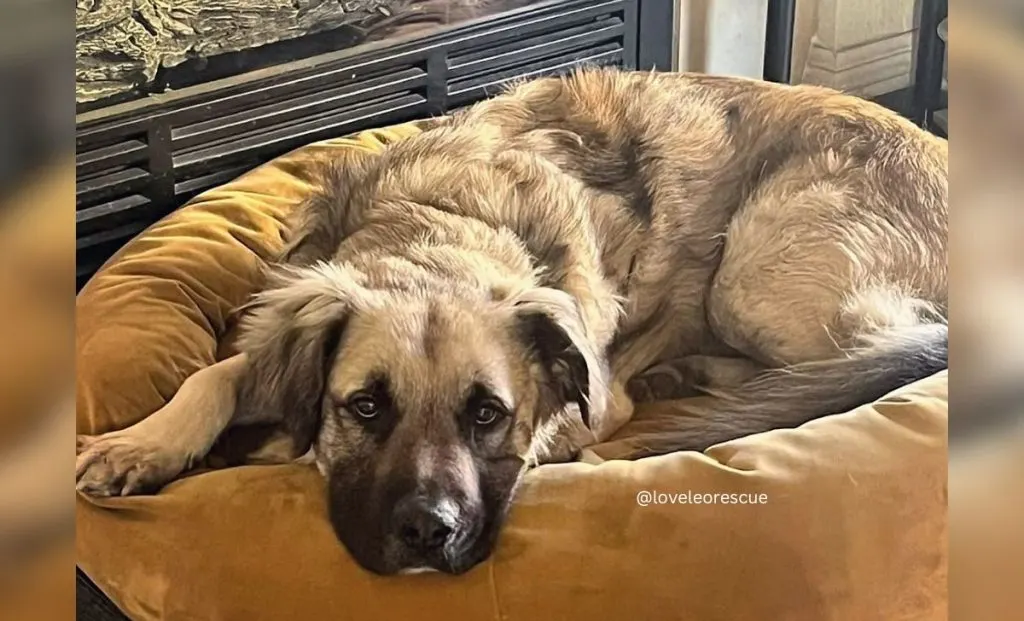
Gray Fawn colors make a nice twist on the classic fawn coat. It retains the familiar fawn color but with an added touch of sophistication.
How? Well, the delicate black banding and/or tips on individual hairs give the coat a deeper, richer appearance.
This unique combination makes the Gray Fawn Anatolian Shepherd stand out with its striking and distinguished look.
6.Red Fawn
Red Fawn is truly a unique Anatolian Shepherd color! This variation takes the classic fawn color and infuses it with vibrant red hues. It creates a stunning and eye-catching appearance.
Red Fawn features warm, red, and ginger tones. This color is also found in American Bullies, French Bulldogs, and Italian Greyhounds.
Don’t you think it expresses a sense of energy and vitality?
7. Liver
This pup stands out for its unique coat color that resembles rich chocolate or deep coffee hues.
Liver color in dogs occurs when they lack the dominant extension gene, “E,” and possess the recessive brown gene, “bb.” So, instead of producing black pigment, this gene results in varying shades of brown. More on the genetic talk later in the article!
Areas of pigmented skin, such as the nose leather, lips, and eye rims, also appear brown instead of black. One of the most interesting things resembling this color is that more often than not, the iris of the eye is lightened.
The gene responsible for liver-colored dogs, also known as chocolate, is commonly found in Belgian Malinois, Shih Tzus, and Labradors.
8.White
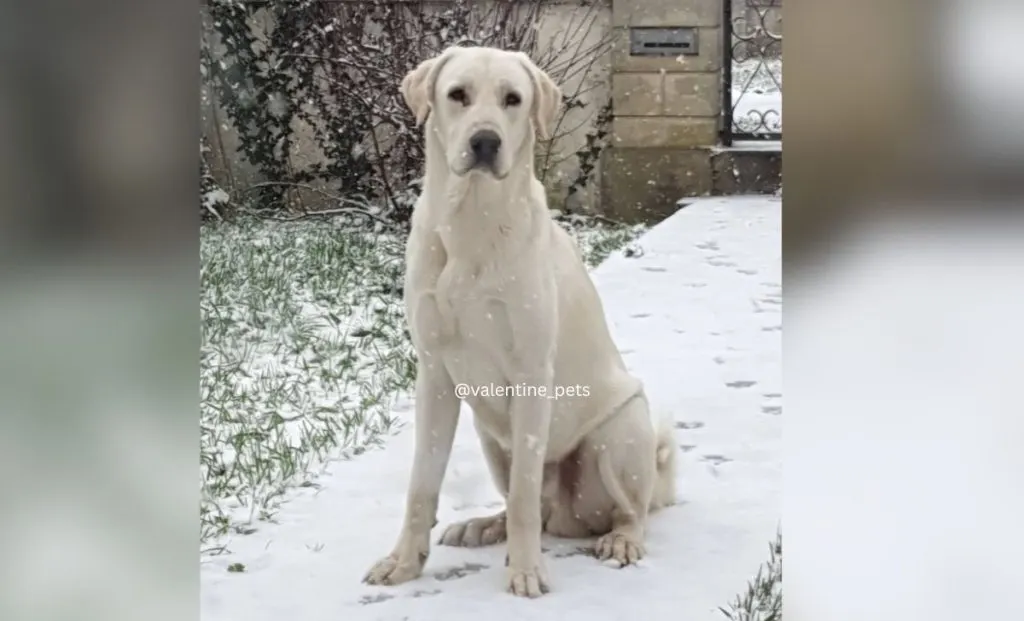
The White Anatolian Shepherd sports a pristine white color coat with a sleek black nose.
While it may appear plain at first glance, it’s important to note that underneath this snowy exterior, they may carry hidden colors.
Often mistaken for Akbash dogs due to their similarities, it’s crucial to recognize that they’re distinct breeds.
White Anatolian Shepherds were once included in the original ASDCA board stud book alongside Akbash dogs. However, they are no longer accepted into Anatolian Shepherd stud books in the US.
With this we have concluded all the colors registered in the AKC. These colors usually come with a set of different markings that cover them.
Which ultimately leads us to our next topic.
Anatolian Shepherd Markings Registered In The American Kennel Club
Anatolian Shepherd markings are a distinctive feature of the breed, commonly seen in varying degrees of dark hues.
These markings typically cover the dog’s muzzle area, with some extending to the eyes or forehead.
They can range from minimal, where the markings are barely noticeable, to very dark, where the entire muzzle appears black. In some cases, heavy markings can also create shading on the chest, toes, or tail.
Markings play a big role in defining the Anatolian Shepherd’s appearance and are a characteristic trait of the breed.
Now let’s cover the main six markings accepted by the AKC breeding standards.
1. Black Mask
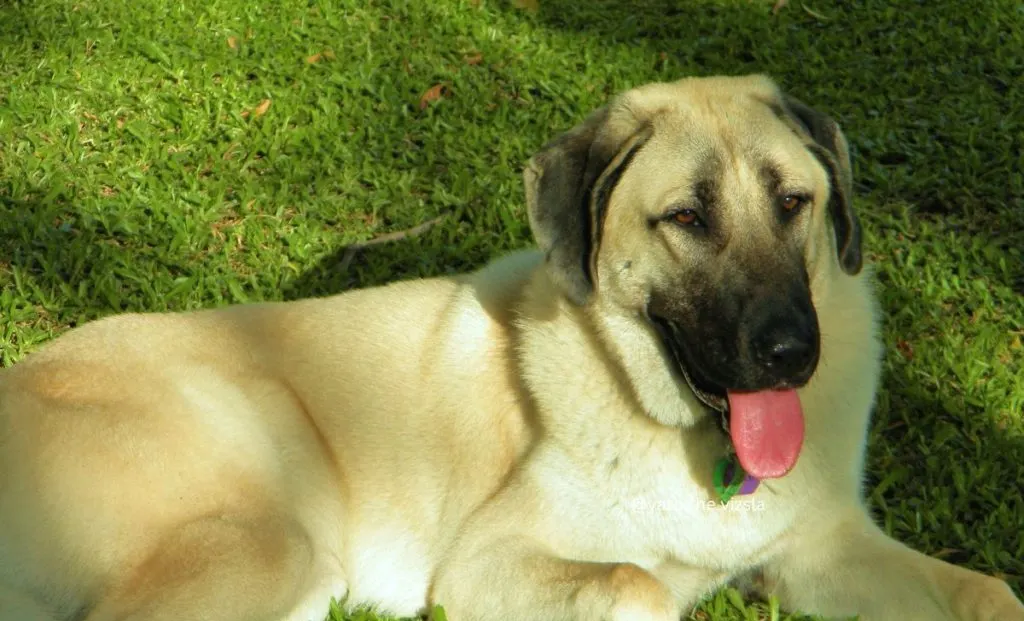
A Black Mask is a common marking within this breed. It comes as a strong contrast to their usually light colored coat.
The most common Fawn Black Mask boasts a fusion of the elegant fawn base color and a dominant black mask gene.
Often referred to as “karabash” or “black head,” this color combination is a beloved classic among livestock guardian dogs.
With that said, it’s no surprise that the Fawn Black Mask is the most popular marking among Anatolian owners.
2. Brown Mask
The Brown Mask in Anatolian Shepherds showcases a unique trait – the recessive brown gene.
This gene transforms their mask and nose leather into a rich brown or liver color, distinct from the typical black markings seen in other variations.
It’s a unique feature that sets them apart within the Anatolian Shepherd breed.
3.Silver Mask
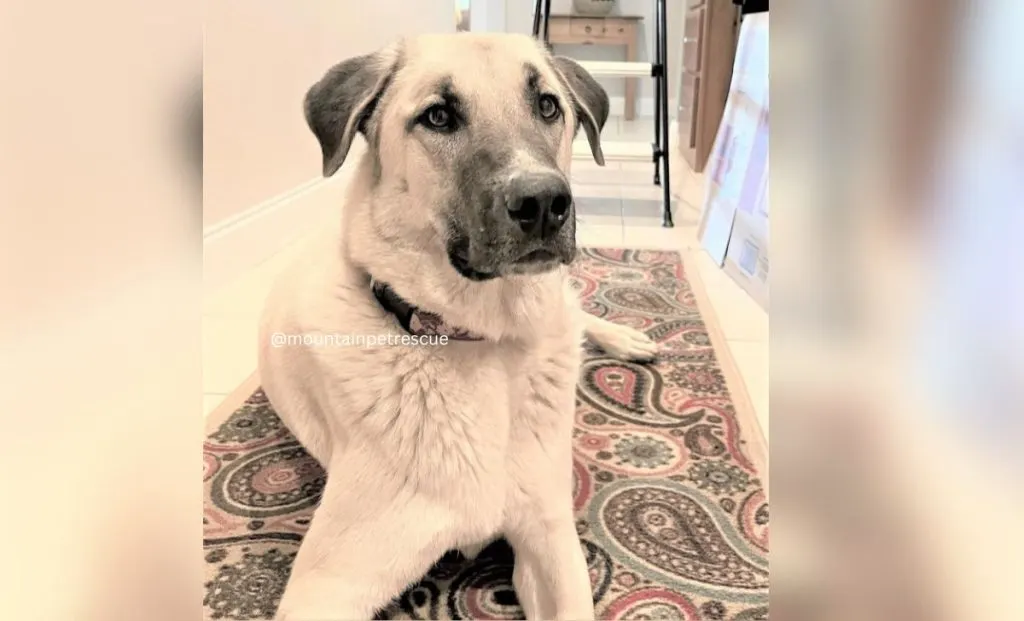
The Silver Mask Anatolian Shepherd has a dilute black gene.
These dogs have lightened eumelanin, which makes their mask and nose leather into a stunning gray color, resembling shimmering silver.
Unlike traditional black masks, these Anatolian Shepherds are considered “more elegant”, and unique!
4. Dutch Markings
An Anatolian Shepherd is considered “Dutch Marked” if it displays a white blaze on its face and a white collar around its neck.
The Dutch Marked Anatolian Shepherd is also known as Irish Marked in many beautiful dog breeds. This interesting marking possesses a unique genetic trait known as the si gene.
This gene, which is not yet screenable, results in varying degrees of white markings on the dog’s socks, collar, and blaze.
5.Pinto
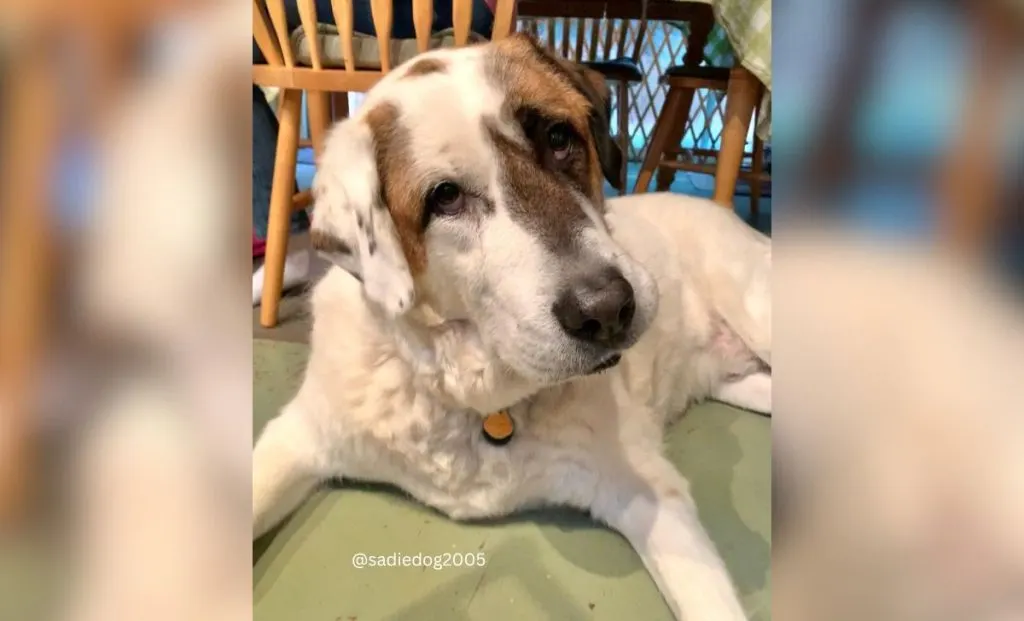
Pinto is characterized by the piebald gene (spsp). This manifests as a white spotting overlay on any base color in the Anatolian Shepherd Dog.
This means that you can commonly find fawn pintos or brindle pintos among these Shepherds.
These recessive color patches are commonly seen on the head, neck, back, and tail.
6.Pinto,Black Mask
Although the AKC breed standards do not support multiple markings on a dog.
The Pinto,Black Mask combination is the only one that’s allowed to participate in competition and is registered in the American Kennel Club.
The Fawn Pinto, Black Mask Anatolian Shepherd features a base color ranging from cream to red, with a prominent white overlay and a distinctive black mask.
Color Genetics Of Anatolian Shepherds
Alright, let’s get to the nerdy and very interesting side of Anatolian Shepherd colors – the canine genetics. The coat color of a dog is indeed influenced by genetic factors and its inheritance is managed by somatic cells.
Every somatic cell houses two versions of each gene, receiving one version from each of the organism’s parents.
Several genes and their specific alleles (variants) play a role in determining coat color and patterns in different breeds.
Scientists have pinpointed four gene loci, each able to hold any of four alleles, and six loci hosting two alleles each.
The primary determinant of coat color in dogs is the production of melanin. Melanin is responsible for the pigmentation of the pup’s hair.
There are two types of melanin:
- eumelanin (black or brown pigment)
- pheomelanin (red or yellow pigment).
Aside from that we’ve categorized ten groups of genes that affect the color of the Anatolian Shepherd’s coat.
That takes us to our next chapter!
10 Categories Of Genes Responsible For Canine Coat Color
1. A series
At the A series, there are four genes that determine coat color, each with varying degrees of dominance.
These genes, listed in order of dominance, are Ay (fawn/sable), Aw (wolf sable), At (tan points), and a (recessive black).
This series is also known as the Agouti series. You may actually see this color in Alaskan Malamutes, Dachshunds, and German Shepherds.
The Agouti pattern regulates how much black and yellow pigment appears on different parts of the dog’s body. They also regulate individual hairs by controlling the production of eumelanin.
2. B-b pair
The B gene specifically influences eumelanin. It carries the instructions for an enzyme that’s crucial for turning brown eumelanin into black.
The dominant “B” allele directs the production of black eumelanin. The recessive “bb” alleles produce brown eumelanin without converting it to black.
Eumelanin typically manifests as a black pigment. This pigment can also be observed in breeds such as the Australian Shepherd.
3. C series
The “C” gene, also known as the Albino Series, plays a role in diluting pigmentation.
It determines whether an animal will have full color pigmentation or one of several levels of color dilution, where pigmentation is reduced.
This gene affects both eumelanin (black pigment) and pheomelanin (red/yellow pigment). Two recessive c alleles can lead to complete albinism or extreme dilution.
Another variant, cch, reduces the red-yellow pigment without affecting the black pigment of the skin.
4. D-d pair
The “D” gene locus, also known as the Blue Dilution Series, is also responsible for diluting pigmentation.
The dominant “D” allele results in full color. D dogs have dense pigmentation, which is common in most dogs. The dd genes produce a diluted or blue phenotype in breeds like the Anatolian Shepherd.
A study highlights that loss-of-function variants in the melanophilin gene (MLPH) cause a recessively inherited form of coat color dilution in many species, including dogs, and corresponds to the D locus in domestic animals (1).
5. E series
Research into the genetics of dog coat color has identified the Em allele as one responsible for the melanistic mask observed in certain breeds, such as the Anatolian Shepherd.
The “E” gene, also known as the Extension Series, determines how black pigment is spread across the dog’s body, controlling the distribution pattern of pigment.
On the other hand, the genes ee result in hairs with no dark pigment. These hairs appear as an evenly distributed shade of red or yellow.
6. G-g pair
The “G” gene, also known as the Gray Series, determines whether a dog will undergo graying as it ages. Like we do!
It is the dominant “G” allele that leads to graying.
On the other hand, dogs with the recessive “gg” alleles do not show any graying as they age.
It is worth noting that graying in dogs happens because of complicated interactions between their genes.
Although we often hear about a “G” gene making things simple, the truth is many genes and controls are involved.
7. M-m pair
The “M” gene, also known as the Merle Series, regulates dilution by causing irregular placement of light and dark patches of color.
Dogs with the mm genotype display uniform pigmentation, while a heterozygous genotype leads to mere coloration.
Canines with the MM genotype, often referred to as double Merles (almost all-white dogs), are typically almost white and may experience severe health issues.
MM genotype creates the Merle pattern in eumelanic areas, whereas the mm genotype indicates normal coloration without any merling.
A study highlighted the significant association between the Merle genotype and deafness, showing that dogs homozygous for the Merle allele (MM) were more likely to be deaf than heterozygotes (Mm) or non-Merles (mm) (2).
8. P-p pair
The “P” gene, also known as the Pigment Series, is considered questionable, as its effects might be influenced by umbrous polygenes.
The term “umbrous” generally refers to a genetic modifier that influences the expression of certain traits, such as coat color, by darkening the phenotype.
The dominant “P” allele results in a full pigment effect.
Anatolian Shepherd dogs with recessive “pp” alleles experience a reduction in dark pigment without affecting red-yellow pigment.
9. S series
The “S” gene, known as the Spotting Series, influences the extent of white spotting in dogs.
White spotting is determined by genes that affect the movement of melanocytes, cells responsible for producing pigment. The dominant “S” allele corresponds to the “No spotting” gene.
The si allele leads to Irish Spotting (Dutch Marking in Anatolians), characterized by a white collar and blaze with white belly, legs, and chest.
The sp allele results in Pinto Spotting , with colored patches on a white background. The sw allele causes Extreme White Pinto, featuring a few small colored spots on a white background.
A study looked at the MITF gene, which is closely related to the S locus. It suggested that the different white spotting patterns we see in dogs, from solid color to a lot of white spots, might not come from single changes in their genes.
Instead, these patterns could be because of various small differences in the gene that affect how it works (3).
10. T-t pair
The “T” gene, also known as the Ticking Series. It is responsible for creating spots of mixed colored and white hairs in otherwise white areas.
The dominant T gene produces flecks or ticks of color on a white background. It’s believed that more than two different alleles contribute to the expression of ticking.
The wild type allele (tt) lacks ticking.
A Quick Overlook Of Color Inheritance In Anatolian Shepherd Dogs
Let’s cover what we’ve learned so far.
The predominant color of the Anatolian Shepherd dog varies from dark fawn to light red.This coat color often includes a variable black muzzle and face, known as a mask.
Evidence suggests that this color is primarily due to the dominant yellow allele (Ay) at the agouti locus. Other frequent colors in Anatolian Shepherds include white spotting, caused by the pinto allele (sp).
Another common variation is a lighter fawn with a blue facial mask, influenced by the dilution allele (d).
There are two rarer colors:
- agouti wolf-grey wild type (A+)
- chinchilla allele (ch).
These are all colorations that happen under normal circumstances. While color mutations don’t happen often, they could still appear unexpectedly.
Can Anatolian Shepherds Be Black?
One of these color mutations gives us a Black Anatolian Shepherd.
The recessive black gene, situated on the A locus, is considered the most recessive.
Black Anatolian Shepherds, also known as melanistic Anatolian Shepherds, are relatively rare but not unheard of. These dogs have a predominantly black coat, which can range from solid black to black with small patches of white or tan.
Dominant black is not typically found in purebred Anatolian Shepherds, as it is found in breeds like Poodles and Giant Schnauzers.
Since this is such a rare occasion most breeders wouldn’t consider Black Anatolian Shepherds to be purebred.
How To Keep Your Anatolian Shepherd Looking Fresh
As we already know every different breed has different needs. Anatolian Shepherd colors and marking can look quite different when their coat is not maintained properly.
The Anatolian Shepherd inherits a double thick coat which sheds heavily twice a year. It requires daily brushing during these times. Good breeders know this coat needs at least weekly attention to minimize shedding and matting, and they will gladly advise new pet parents on this.
Sad reality is that many owners surrender their Anatolian Shepherd dogs to shelters or rescue groups due to the unexpected maintenance requirements.
Despite mainly working with livestock, baths are rarely needed as brushing helps remove any odor from their thick undercoats.
Aside from that, it’s important to keep their big ears clean and dry to prevent infections. Nails should be regularly trimmed, about once every two weeks, though this varies from dog to dog.
Their teeth should be checked weekly and brushed often to prevent dental disease, an illness that can become very serious if not prevented/treated on time.
An active puppy radiates the freshness! Anatolian Shepherd dogs are not particularly high-energy. A daily long walk or a playful session in a securely fenced yard should be adequate for their exercise needs.
Keep in mind that Anatolian Shepherd dogs are prone to hereditary diseases such as hip dysplasia, elbow dysplasia, and hypothyroidism. Therefore, securing pet health insurance can help manage potential veterinary costs.
References
- Bauer, A., Kehl, A., Jagannathan, V., & Leeb, T. (2018). A novel MLPH variant in dogs with coat colour dilution.. Animal genetics, 49 1, 94-97 . https://doi.org/10.1111/age.12632.
- Strain, G., Clark, L., Wahl, J., Turner, A., & Murphy, K. (2009). Prevalence of deafness in dogs heterozygous or homozygous for the merle allele.. Journal of veterinary internal medicine, 23 2, 282-6 . https://doi.org/10.1111/j.1939-1676.2008.0257.x.
- Baranowska Körberg I, Sundström E, Meadows JR, Rosengren Pielberg G, Gustafson U, Hedhammar Å, Karlsson EK, Seddon J, Söderberg A, Vilà C, Zhang X, Åkesson M, Lindblad-Toh K, Andersson G, Andersson L. A simple repeat polymorphism in the MITF-M promoter is a key regulator of white spotting in dogs. PLoS One. 2014 Aug 12;9(8):e104363. doi: 10.1371/journal.pone.0104363. PMID: 25116146; PMCID: PMC4130573.

Meet Iram, a devoted veterinarian, passionate dog lover, and current Ph.D. candidate at Utrecht University in the Netherlands. Seamlessly blending her roles as a vet and content writer, Iram channels her love for dogs into heartfelt narratives.
Since childhood, Iram nurtured a dream of becoming a vet, a passion that runs deep in her family. Having now fulfilled that dream, she’s eager to share her acquired knowledge. In her writing, Iram not only explores the emotional bond between humans and their canine friends but also integrates her veterinary expertise, offering readers a holistic understanding of their beloved pets.
